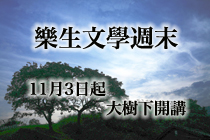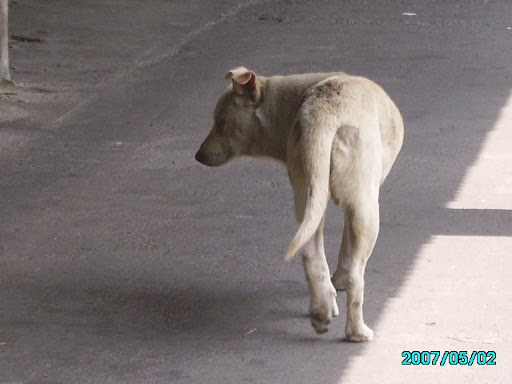http://www.erenlai.com/index.php?aid=1812
BermanRoy, 紐約 08.25.2008
A visit to Losheng sanitarium in Taiwan
Today I visited Taiwan’s famous Losheng Sanitarium (樂生療養院), a leper colony built by the Japanese colonial government in Xinzhuang City, Taipei County. As in leper colonies throughout the world, Taiwanese victims of Hansen’s Disease were forcibly imprisoned in Losheng by the government, as they were in Japan by the government there. Although the leper imprisonment order was lifted in Taiwan in the 1950s , they have for the most part remained. With modern medicine the patients are no longer inmates, and no longer contagious, but nothing can de-cripple them or regrow their missing fingers and stumpy limbs. And they have nowhere to go, and no way to survive except by public welfare of some sort.
I had first heard of Losheng perhaps a couple of years ago, due to the wave of protests to the government’s plan to demolish the entire complex to make way for a train depot, as part of Taipei metro’s never-ending expansion plan. Although there are naturally no opponents to MRT expansion itself, there have been severe doubts regarding the sense of building the depot in this particular location, which apparently requires the leveling of mountain to create flat ground which naturally occurs elsewhere and is widely suspected of having been chosen to satisfy local political interests before practical considerations of engineering.
Primary opposition to the plan however, is due to a desire to preserve Losheng. The adage goes something like, you never really appreciate something to it’s gone, and it is born out time and again in the history of urban preservation. New York City’s historical preservation regime was established in the wake of the foolhardy and abhorrent demolition of Penn Station in the 1960s, and throughout the world preservationist activity is often triggered by the threat of imminent loss. The government’s plan to demolish the place made people realize for the first time that it was worth preserving, and recent protests have spurred a surge of interest in the hospital site and its residents that has gone beyond simple preservationism to community organizing attempting to integrate Losheng, which for most of its existence was in principle as isolated as a prison, into the surrounding community. This has led to large numbers of non afiliated visitors spending time with the patients for probably the first time in many years, if not ever.
It turns out that from the articles I had read in The Taipei Times, not to mention the briefer pieces I saw in Japanese media I had no idea what it was like. When I read about a hospital/leper sanitarium being destroyed to make way for MRT construction I had for some reason imagined a cluster of shabby old buildings on a city street corner. But of course a leper colony could not be in such a place, and is in fact built on slightly elevated and up-sloping terrain on mountain foothills of a part of Taipei county that, at the time, was mostly farmland. Less a modern style hospital or a prison, Losheng is actually a sprawling and rather pleasant, almost collegiate-looking, campus with abundant greenery and attractive brick buildings. The main hospital building looks properly medical, and the general sense of design reflects its Japanese period origins, with semi-exposed corridors reminiscent of the older buildings on the Japanese Imperial Universities of the early 20th century, such as today’s National Taiwan University or Kyoto National University (the two examples whose architecture I am familiar with). Most other buildings are also in the pre-war Japanese style common in Taiwan, with a few notable exceptions. The least Japanese buildings in Losheng are probably the Buddhist temple, which is in standard Taiwanese style, and the now shuttered Catholic Church, which is perhaps the most spartan Catholic church building I have ever seen, with only a spare cross on the roof and no writing of any kind on the outside, but with a green Chinese roof, oddly complete with dragon tiles on the corners, and outer walls painted in the Chinese temple fashion. It reminds me of nothing so much as the far more elaborate Tainan Catholic cathedral, which is constructed and painted completely in the manner of a Chinese temple, if you do not look too close at the paintings. Of particular interest are the residence buildings for patients (originally, remember, inmates) from particular parts of Taiwan, such as Penghu or Tainan, donated by the governments of that region.
I mentioned above activity integrating the Losheng campus into the greater community. This consists of various activities, such as holding lectures and community meetings inside Losheng, or educational programs for children. As chance had it, I happened to go on a day which was particularly active. Community activists are currently running a summer camp for children from various elementary schools in the area, using various Losheng buildings for different activities. I was taken to see the room being used for a week-long Japanese language class run by a Japanese woman studying a PhD in Urban Planning at National Taiwan University, in the room of the hospital building where the sickest patients were brought, connected by a locked iron door to the much smaller room where they were taken to die. This is either morbidly incongruous beyond belief, or an excellent symbol of the way in which the space is being reclaimed and repurposed from its grim past. But little of that darkness remains. The staff (mostly Taiwanese college students) had cleaned the room fastidiously, and it was festooned with child drawings illustrating various basic Japanese words and phrases.
Then I went to a much larger room, a sort of meeting hall I suppose, where the kids were being led in Japanese songs by some of the old patients who remember their Japanese well. One played the keyboard-no easy task with hands ravaged by Hansen’s Disease, while another sat in front of the stage in his motor chair, leading the children in Furosato.
After the class was over, I spent some time speaking to the old men, who seemed both movingly thrilled and slightly amazed to have so many young people, children, teenagers and 20-somethings, having fun inside Losheng and spending time with the patients as human beings, and not afraid of their no longer contagious disease. As is the case with many elderly Taiwanese, their first language is Taiwanese (aka Minnan, Hoklo, Fukkianese, etc.) Their Mandarin is generally weak and heavily accented, and most of them also speak Japanese to some degree, having undergone elementary education during the colonial period. I spent the most time speaking with one old man, Chang Wen-pin 张文贫, whose fluent Japanese was easily the best out of the group.
Mr. Chang, now 81 if my calculations are correct, went to a Japanese colonial elementary school in Taiwan and worked as, I think, a locksmith both under the Japanese and in the early years of the KMT, before he was interned. He was around 20 years old at the time of the 228 incident, and considers Chiang Kai-shek to be the worst thing to have happened to Taiwan.
To paraphrase, translated and from memory:
Taiwan’s history is full of tragedy. After WW2 Taiwan shouldn’t have been given to Chiang Kai-shek, but instead the allies should have occupied it. America, England and Russia should have managed Taiwan and then organized it for independence. If they had done that then we would have avoided the 228 massacre and noone in Taiwan would be speaking Mandarin (lit: guoyu) today!
Mr. Chang and the others made me promise to come back and visit next time I come to Taiwan, and before I left he made me wait while he went back to his room and brought a copy of the photo and essay book about Losheng assembled by the preservationist activists, which he signed and gave to me.
Countless speakers have said that “A society is ultimately judged by how it treats its weakest and most vulnerable members.” The leper has always been a symbol for the lowest in society, and despite having no use for religion myself, I think I can understand why Mr. Chang finds his solace in Christianity, a religion in which the leper is a symbol not of disgust, but of redemption. It says a lot of a society in which lepers are no longer lepers, but patients, and the resurrection of Losheng from a medical prison into a park where children play may be taken as a symbol for Taiwan’s transformation from colony and then military dictatorship into the relatively free and effectively independent country that it is today. But the current metro expansion plan still requires the demolition of something like 30-40% of Losheng’s territory, with some buildings kept in place, a few relocated, and many destroyed entirely. Even the preservationists have abandoned their attempts to save the entire site, with construction of the nearby depot building already well under way, and their best case plan today is the “90% plan.” There is still room for improvement.
---------------------------------------------
Also visit with Roy
Shinbashi ruins













![[漢生病的開放故事互動表演]行動](https://blogger.googleusercontent.com/img/b/R29vZ2xl/AVvXsEjvVgi45QQ7iUl2ZwJISj0H4H3nm8YRwD4G7tDf28G1DeWBIKjWysHrFPQgvoYgerkoOWBy7rCZvkGexTVbUMIWSOXvTPU1-cE6Bo8pxxu7RuEZaGvvJyzsrCdlC2bLFPzrCGO9DuDyLB_o/s1600-r/%E6%BC%A2%E7%94%9F%E7%97%85%E7%9A%84%E9%96%8B%E6%94%BE%E6%95%85%E4%BA%8B%E4%BA%92%E5%8B%95%E8%A1%A8%E6%BC%94-LO.gif)






0 意見:
張貼留言